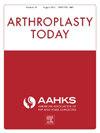Impact of Benign Prostatic Hyperplasia on Postoperative Complications and Periprosthetic Joint Infections After Total Joint Arthroplasty: A Systematic Review and Meta-Analysis
IF 1.5
Q3 ORTHOPEDICS
引用次数: 0
Abstract
Background
Total joint arthroplasty (TJA) is one of the most frequently performed surgical procedures each year, offering considerable cost-effectiveness and numerous benefits. However, certain postoperative complications can be observed following TJA. While the relationship between various comorbidities and these complications has been well-documented, this study aims to specifically investigate the impact of benign prostatic hyperplasia (BPH) on postoperative outcomes.
Methods
For this systematic review, we searched PubMed, Scopus, and Web of Science using terms like "total hip arthroplasty," "total knee arthroplasty," "BPH," and "benign prostatic hypertrophy." Screening of retrieved articles was conducted according to Preferred Reporting Items for Systematic Reviews and Meta-Analyses guidelines. Studies comparing complications in TJA between patients with and without preexisting BPH were eligible for inclusion. Data extraction was performed on the included articles, and their quality was assessed using the Newcastle-Ottawa scale. A meta-analysis was conducted using the Mantel-Haenszel method.
Results
This systematic review encompassed 4 articles evaluating TJA outcomes in men with a history of BPH, involving a total of 75,222 male cases. Among these, 17,183 cases (23%) presented with symptomatic BPH. The meta-analysis revealed that the incidence rate of periprosthetic joint infection did not significantly differ between BPH and non-BPH groups across both total hip and knee arthroplasty cases (odds ratio [OR] (95% confidence interval [CI]) = 1.28 [0.92-1.79]). However, postoperative urinary retention was significantly higher among patients with BPH (OR [95% CI] = 3.43 [2.04-5.78]). Additionally, patients with BPH exhibited a notably elevated incidence of postoperative urinary tract infection (OR [95% CI] = 2.55 [2.33-2.79]), as well as sepsis (OR [95% CI] = 1.31 [1.09-1.58]).
Conclusions
It is noteworthy that while patients with BPH are prone to certain complications, meta-analysis indicate that BPH cannot be considered a comorbidity that increases the risk of periprosthetic joint infection.
良性前列腺增生对全关节成形术后并发症和假体周围感染的影响:系统回顾与元分析
背景全关节置换术(TJA)是每年最常见的外科手术之一,具有相当高的成本效益和众多优点。然而,TJA 术后可能会出现某些并发症。虽然各种合并症与这些并发症之间的关系已得到充分证实,但本研究旨在专门调查良性前列腺增生症(BPH)对术后结果的影响。方法在这篇系统性综述中,我们使用 "全髋关节置换术"、"全膝关节置换术"、"BPH "和 "良性前列腺肥大 "等术语检索了 PubMed、Scopus 和 Web of Science。根据《系统综述和元分析首选报告项目》指南对检索到的文章进行筛选。对患有和未患有良性前列腺增生症的患者进行TJA并发症比较的研究符合纳入条件。对纳入的文章进行数据提取,并使用纽卡斯尔-渥太华量表对其质量进行评估。结果该系统性综述包括4篇评估有良性前列腺增生病史的男性TJA结果的文章,共涉及75222例男性病例。其中,17183 例(23%)有症状的良性前列腺增生。荟萃分析显示,在全髋关节和膝关节置换术病例中,BPH 组和非 BPH 组的假体周围关节感染发生率没有显著差异(几率比 [OR] (95% 置信区间 [CI]) = 1.28 [0.92-1.79])。然而,良性前列腺增生患者的术后尿潴留率明显更高(OR [95% CI] = 3.43 [2.04-5.78])。此外,良性前列腺增生患者术后尿路感染(OR [95% CI] = 2.55 [2.33-2.79])和败血症(OR [95% CI] = 1.31 [1.09-1.58])的发生率明显升高。
本文章由计算机程序翻译,如有差异,请以英文原文为准。
求助全文
约1分钟内获得全文
求助全文
来源期刊

Arthroplasty Today
Medicine-Surgery
CiteScore
2.90
自引率
0.00%
发文量
258
审稿时长
40 weeks
期刊介绍:
Arthroplasty Today is a companion journal to the Journal of Arthroplasty. The journal Arthroplasty Today brings together the clinical and scientific foundations for joint replacement of the hip and knee in an open-access, online format. Arthroplasty Today solicits manuscripts of the highest quality from all areas of scientific endeavor that relate to joint replacement or the treatment of its complications, including those dealing with patient outcomes, economic and policy issues, prosthetic design, biomechanics, biomaterials, and biologic response to arthroplasty. The journal focuses on case reports. It is the purpose of Arthroplasty Today to present material to practicing orthopaedic surgeons that will keep them abreast of developments in the field, prove useful in the care of patients, and aid in understanding the scientific foundation of this subspecialty area of joint replacement. The international members of the Editorial Board provide a worldwide perspective for the journal''s area of interest. Their participation ensures that each issue of Arthroplasty Today provides the reader with timely, peer-reviewed articles of the highest quality.
 求助内容:
求助内容: 应助结果提醒方式:
应助结果提醒方式:


